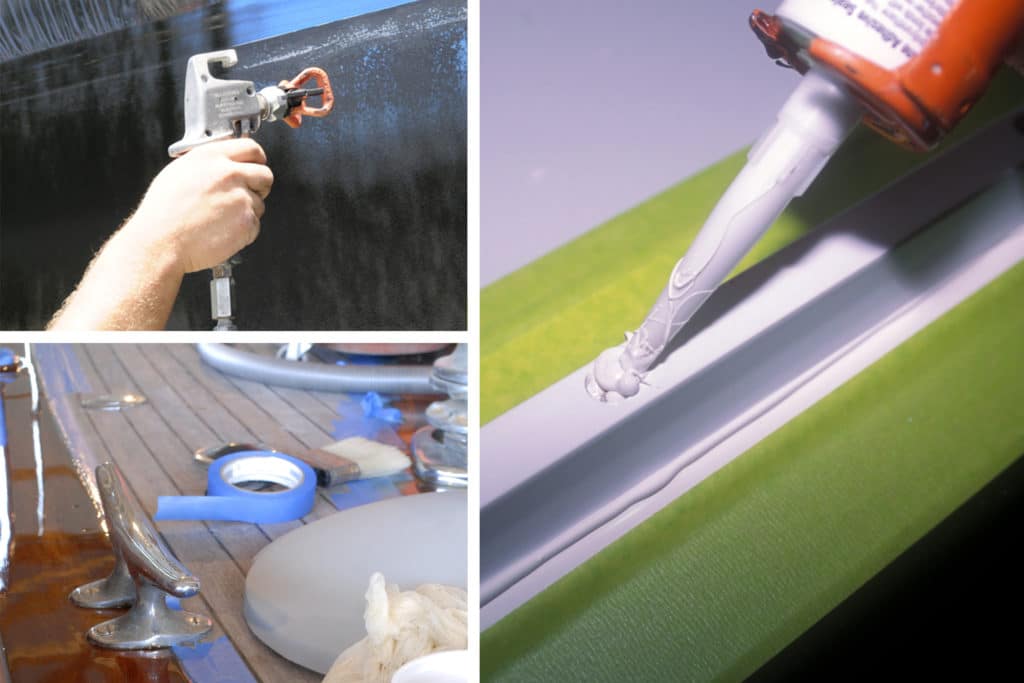
Where masking tape is concerned, the first matter to address is whether you wish to leave the tape in place, exposed to the elements (including dew), for more than 24 hours. If not, you (and your wallet) are in luck. Except when used with two-part coatings, good old khaki-colored masking tape, the type that’s been around for decades, is fine. While you wouldn’t want to use it to pull a fine line, such as a boot or sheer stripe, it will work well for antifouling paint and many other less-than-precise applications.
At just 4 or 5 dollars a roll, this tape is inexpensive, and you won’t feel too bad if a roll is left out in the rain, which will almost certainly render it unusable (one of my pet peeves when I ran a boatyard). If you require greater definition to an edge and a finer line — as well as resistance to solvents and two-part paints — a high-performance version of this tape (3M 218 Fine Line masking tape) is available for about $17 a roll, depending on the width. This tape can be stretched to make smooth curves, but it also can be torn without using a knife as you complete a run.
Again, beware: These types of masking tape are, for the most part, not weather-resistant. Even storing them in a damp environment can destroy them. It’s hard to watch a boat owner laboriously mask off brightwork, apply a coat of varnish and then not return straightaway because the weather turns poor for a week or two. When it comes time to remove this tape, it will stubbornly resist. Much of it will be left behind as strips are pulled up and torn, often requiring the use of a razor scraper and adhesive remover. Upon exposure to moisture — it takes nothing more than dew to wreck it — this tape will separate from its adhesive, leaving a formidable cleanup task for the unwary user.
These days there’s a wide range of masking-tape options beyond the standard variety, too many to list all of them here. However, a couple are especially useful and noteworthy. For any masking job that may be exposed to rain and sun for up to seven days (or 14 days indoors), you must move up to the next level of tape sophistication. In that case, 3M’s blue medium-adhesion masking tape fits the bill. Medium adhesion means it’s unlikely to pull paint and varnish off with it as it’s removed. (There are other tape manufacturers besides 3M, but my experience is with this dependable brand; the company invented masking tape in 1925.) If your project will last longer than this, and you don’t wish to remove and replace tape every seven days, then silver masking tape is the right choice, as it can be used outdoors for more than 30 days. In fact, I’ve used it for twice this duration, but plan on a minimum of a month. This tape is also useful for temporary on-deck repairs, such as a leaky hatch.
All masking tapes are not very strong, nor are they meant to be. But if you simply need a moisture barrier, the silver variety works well. Avoid the temptation to use duct tape for any temporary on-deck repair. Once it’s wet, its backing separates from its tenacious glue, which is extremely difficult to remove.
In short, determine what you will need in the way of weather resistance, chemical compatibility and the fineness of the line before reaching for a roll of masking tape. 3M and other tape manufacturers provide detailed sales information for all of their products, making the selection process relatively easy. Lastly, here’s a tip: The natural tendency when removing tape is to pull it at 90 degrees to the surface. That’s fine if the surface is gelcoat, but if, for instance, it’s an old varnished sole or recently applied enamel paint, there’s a risk of pulling the coating with it. To avoid that, pull the tape back closer to 180 degrees. By doing so, you’ll create less stress on the coating’s bond.
Steve D’Antonio offers services for boat owners and buyers through Steve D’Antonio Marine Consulting www.stevedmarineconsulting.com.








